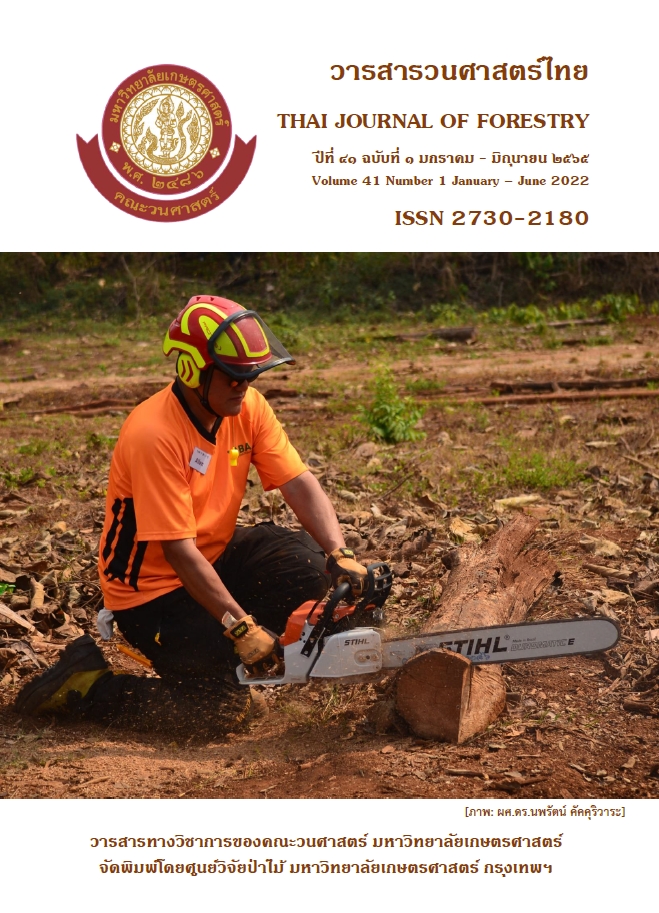การประเมินต้นนางพญาเสือโคร่งในพื้นที่ภูลมโล อุทยานแห่งชาติภูหินร่องกล้า จังหวัดพิษณุโลก
Main Article Content
บทคัดย่อ
การศึกษานี้มีวัตถุประสงค์เพื่อสำรวจและประเมินสภาพต้นนางพญาเสือโคร่งในพื้นทีภูลมโล อุทยานแห่งชาติภูหินร่องกล้า จังหวัดพิษณุโลก โดยประเมินสภาพปัญหาจะส่งผลกระทบต่อการโค่นล้ม การยืนต้นตายของต้นนางพญาเสือโคร่ง และจัดทำฐานข้อมูลพื้นฐานของต้นนางพญาเสือโคร่ง เพื่อให้หน่วยงานที่รับผิดชอบใช้ในการวางแผน จัดการดูแลรักษาต่อไป จากการศึกษา ได้เลือกใช้วิธีการประเมินสภาพต้นไม้ใหญ่ (Tree Assessments) มาทำการประเมินสภาพต้นนางพญาเสือโคร่งในพื้นที่ภูลมโล ทำการเก็บข้อมูลโดยการประยุกต์และดัดแปลงแบบฟอร์มการเก็บข้อมูลภาคสนามตามสภาพปัญหาที่เจอตามส่วนต่าง ๆ ของต้นนางพญาเสือโคร่ง และนำมาประเมินความเสี่ยงที่จะส่งผลกระทบต่อความเสียหายหากมีการโค่นล้ม หรือยืนต้นตายของต้นนางพญาเสือโคร่งในพื้นที่ภูลมโล ตามวิธีประเมินความเสี่ยงต้นไม้ขั้นพื้นฐาน ISA (International Society Arborist) Basic Tree Assessment 2017
ผลจากการสำรวจต้นนางพญาเสือโคร่งทั้งหมดที่ขึ้นอยู่ ในพื้นที่ ภูลมโล พบว่ามีจำนวนทั้งหมด 19,356 ต้น พบต้นที่มีสภาพปัญหาตามลำต้นและกิ่ง 398 ต้น คิดเป็น 2.06 % นำมาทำการประเมินตามเกณฑ์ ตามสภาพปัญหาของลำต้น พบต้นนางพญาเสือโคร่งที่มีความเสี่ยงขั้นร้ายแรง 6 ต้น (1.51%) ความเสี่ยงสูง 63 ต้น (15.83%) ความเสี่ยงปานกลาง 137 ต้น (34.42%) ความเสี่ยงต่ำ 192 ต้น (48.24%) ตามสภาพปัญหาของกิ่ง ไม่พบต้นนางพญาเสือโคร่งที่มีความเสี่ยงขั้นร้ายแรงและความเสี่ยงสูง พบแต่ต้นนางพญาเสือโคร่งที่มีความเสี่ยงปานกลาง 3 ต้น (18.75%) และมีความเสี่ยงต่ำ 13 ต้น (81.25%) ทั้งนี้ สภาพปัญหาที่พบ คือ ลำต้นเปลือกแหว่งหาย มีรอยปูดบวม ลำต้นเป็นโพรง กาฝาก ผุ โค้งงอเอนล้ม ซึ่งมีโอกาส จะสร้างความเสียหายต่อการท่องเที่ยวในอนาคต จึงควรมีการวางแผนการดูแลรักษาอย่างเหมาะสม และทันท่วงทีโดยผู้เชี่ยวชาญเฉพาะทาง
Downloads
Article Details

อนุญาตภายใต้เงื่อนไข Creative Commons Attribution-NonCommercial-NoDerivatives 4.0 International License.
ข้าพเจ้าและผู้เขียนร่วม (ถ้ามี) ขอรับรองว่า ต้นฉบับที่เสนอมานี้ยังไม่เคยได้รับการตีพิมพ์และไม่ได้อยู่ในระหว่างกระบวนการพิจารณาตีพิมพ์ลงในวารสารหรือสิ่งตีพิมพ์อื่นใด ข้าพเจ้าและผู้เขียนร่วม (ถ้ามี) ยอมรับหลักเกณฑ์และเงื่อนไขการพิจารณาต้นฉบับ ทั้งยินยอมให้กองบรรณาธิการมีสิทธิ์พิจารณาและตรวจแก้ต้นฉบับได้ตามที่เห็นสมควร พร้อมนี้ขอมอบลิขสิทธิ์ผลงานที่ได้รับการตีพิมพ์ให้แก่วารสารวนศาสตร์ คณะวนศาสตร์ มหาวิทยาลัยเกษตรศาสตร์ กรณีมีการฟ้องร้องเรื่องการละเมิดลิขสิทธิ์เกี่ยวกับภาพ กราฟ ข้อความส่วนใดส่วนหนึ่ง หรือ ข้อคิดเห็นที่ปรากฏในผลงาน ให้เป็นความรับผิดชอบของข้าพเจ้าและผู้เขียนร่วม (ถ้ามี) แต่เพียงฝ่ายเดียว และหากข้าพเจ้าและผู้เขียนร่วม (ถ้ามี) ประสงค์ถอนบทความในระหว่างกระบวนการพิจารณาของทางวารสาร ข้าพเจ้าและผู้เขียนร่วม (ถ้ามี) ยินดีรับผิดชอบค่าใช้จ่ายทั้งหมดที่เกิดขึ้นในกระบวนการพิจารณาบทความนั้น”
เอกสารอ้างอิง
Bouaziz, F., Koubaa, M., Ghorbel, R.E., Chaabouni, S.E. 2016. Recent advances in Rosaceae gum exudates: From synthesis to food and non-food applications. International Journal of Biological Macromolecules 86: 535-545.
Department of National Parks, Wildlife and Plant Conservation. 2020. National Park Tourism Guide. Tourism and Recreation Management Division. National Park Office Department of National Parks Wildlife and Plant Species, Bangkok (In Thai)
Elliott, S., Kuarak, C., Navakitbumrung, P., Zangkum, S., Anusarnsunthorn, V., Blakesley, D. 2002. Propagating framework trees to restore seasonally dry tropical forest in northern Thailand. New Forest 23: 63-70.
Elliott, S., Navakitbumrung, P., Kuarak, C., Zangkum, S., Blakesley, D., Anusarnsunthorn, V. 2001. Testing framework species for restoring biodiversity on degraded forestland in northern Thailand. Proceedings of Tropical Forest Symposium: the Art and Practice of Conservation Planting. The Biodiversity Research and Training Program, Bangkok, pp 210-217.
Forest Restoration Research Unit. 2005. How to Plant a Forest: The Principle and Practice of Restoring Tropical Forest. Biology Department, Science Faculty, Chiang Mai University, Thailand.
Guo, Y., Kramer, M., Pooler, M. 2018. Screening ornamental cherry (Prunus) taxa for resistance to infection by Blumeriella jaapii. HortScience 53(2): 200-203.
Jim, C.Y., Zhang, H. 2013. Defect-disorder and risk assessment of heritage trees in urban Hong Kong. Urban Forestry & Urban Greening 12: 585–596.
Joseph, N., Anjum, N., Tripathi, Y.C. 2018. Prunus cerasoides D. Don: A review on its ethnomedicinal uses, phytochemistry and pharmacology. International Journal of Pharmaceutical Sciences Review and Research 48(1): 62-69.
Mathayomburut, W. 2018. Tourism management model. Phu Hin Rong Kla National Park Phitsanulok Province. Principal Journal. Thaksin University. (In Thai)
Northern Silvicultural Research Center. 2012. Plants in Pots at the Northern Forest Research Center. Office of Forest Research and Development, Bangkok. (In Thai)
National Medicinal Plants Board. 2016. Argo-Techniques of Selected Medicinal Plants Volume 3. Ministry of Ayush, New Delhi, India.
Organisation for Economic Cooperation and Development. 2006. Safety Assessment of Transgenic Organisms Volume 2: OECD Consensus Documents. Harmonisation of Regulatory Oversight in Biotechnology. OECD Publishing, Paris.
Pakkad, G., Elliott, S., Blakesley, D. 2004. Selection of Prunus cerasoides D. Don seed trees for forest restoration. New Forest 28(1): 1-9.
Panyawuttrakul, W. 2018. Management of highland tourism communities Phu Lom Lo case study and sustainable linkage areas. Journal of Liberal Arts Ubon Ratchathani University 14(1): 151-197. (In Thai)
Pernek, M., Lackovic, N., Macak, A., Stamenković, V. 2013. Adapted VIA and SIA method in tree static assessment with use of resistography. Periodicum Biologorum 115: 447-453.
Smiley, E.T., Matheny, N., Lilly, S. 2017. Best Management Practices: Tree Risk Assessment, second edition. International Society of Arboriculture, Champaign, IL.
Smitinan, T. 2014. Plant Names of Thailand. Amended edition. Office of Plant Research Office Conservation of Forests and Plant Species Department of National Parks, Wildlife and Plant Conservation of Natural Resources and Environment, Bangkok. (In Thai)


